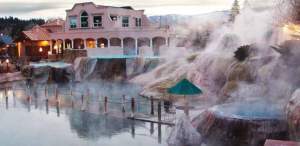
The Springs Resort is one of two spas that make use of minerally-rich water from the same hot springs used for space heating in Pagosa. Geothermal water rights have been obtained to put the water to beneficial use. Photo by Dick Stenzel.
Early this month, the Colorado School of Mines Geophysics Department released results of research, studying characteristics of the area’s geothermal aquifer, while Saturday saw Pagosa’s Geothermal Greenhouse Partnership hosting a fundraiser. According to the Pagosa Sun, the School of Mines researchers found that the geothermal resources might be more extensive than had been predicted, but more research is needed:
It was that last sentence that suggested more research was required to accumulate more data on the aquifer. In fact, CSM faculty has already scheduled a return visit to Pagosa Country in September (with a smaller contingent of researchers returning for that work) and, quite possibly, another large-scale field camp mobilizing in the area next May — similar to the one organized earlier this year.
As the Colorado Foundation for Water Education recently published in Headwaters Magazine, much of Pagosa is invested in the town’s hot springs:
The small town of Pagosa Springs is named for its claim to fame: the largest and deepest hot springs on the planet. The springs provide a tourist draw—and a renewable energy source. Since 1982, the town has operated a geothermal heating system, supplying hot water used for space heating to 13 commercial and two residential customers, including local schools, churches, a bank and the jail. Still, residents of Pagosa hope to do more, like use thermal energy for additional space heating, to warm a system of greenhouses, to develop a fish hatchery, maybe to create a botanical education program—maybe
“We’re trying to look at the resources we have here—of course geothermal is one,” says Phil Starks, sanitation supervisor for Pagosa Springs. At the town’s bidding, students from the Colorado School of Mines in Golden and researchers with the Frisco-based Geothermal Management Company are conducting a feasibility study this year to determine whether Pagosa’s hot springs can be further developed and to identify the degree of additional
energy that could be obtained.One concern researchers will evaluate is whether additional development could deplete the springs or cause decreases in pressure that would impact existing geothermal users. Provided the researchers find that is not the case, they will suggest additional ways to make use of the water, most likely
for additional space heating, aquaculture or agribusiness, says consultant Gerry Huttrer with the Geothermal Management Company.A positive outcome would please the Geothermal Greenhouse Partnership, a group that’s been working to engage the community and obtain land, water and funding to build greenhouses where residents can grow food, educate their children and attract tourists. “We do feel that this is something the community will take pride in— it will highlight this great resource,” says Kathy Keyes, a founding member of the partnership. “It’s an intrinsic resource that we can use to further ourselves.”


 Print
Print
Hi,
My name is Jane and I’m with Dwellable.
I was looking for blogs about Pagosa Springs to share on our site and I came across your post…If you’re open to it, shoot me an email at jane(at)dwellable(dot)com.
Hope to hear from you, and Happy Holidays!
Jane
You can check out my All Things Pagosa site as well!